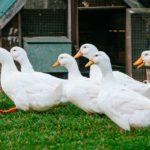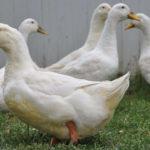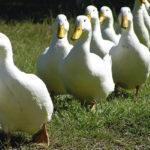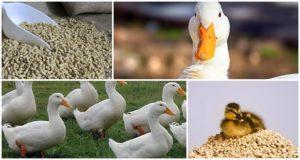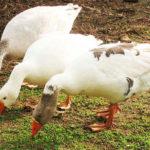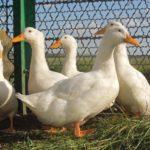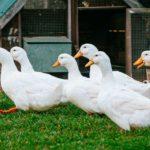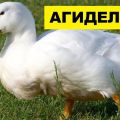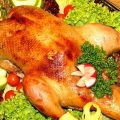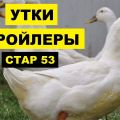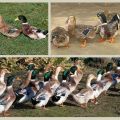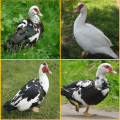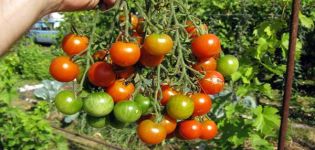How to raise and breed Peking ducks at home
Peking duck is one of the best meat duck breeds. It is not only bred everywhere, but also used in breeding work to breed other varieties. Consider the description and characteristics, pros and cons, as well as the technology of breeding Peking duck at home, the feeding diet, the requirements for the conditions of keeping and caring for this breed.
History of origin and distribution
The breed was bred about 3 centuries ago in China. In the 19th century, the Peking duck was introduced to America and then to Europe. Now in poultry farming the breed is widespread both on industrial farms and in private farmsteads. Many duck breeds, including broiler breeds, then evolved from this breed.
Description and characteristics of the Peking duck
The duck has a powerful constitution, it has a wide back and chest, a large head, and an arched neck. It has a prominent forehead and a large, flat bright orange beak. Large wings and a small tail with a raised end. Legs are short, plumage is dense. Its color is predominantly pure white, although there are birds with cream plumage.
Drakes and ducks are almost the same in size, but larger than musky ones. When crossed with them, they give mulards, which grow larger than their parents. Peking females lay eggs of white or bluish color, without a specific smell and taste. Productivity characteristic:
- the weight of an adult drake is 3.5-4 kg, ducks - 3-3.5 kg;
- weight of 2-month-old ducklings - 2.7-3 kg;
- the number of eggs laid per year - 150 pcs. (each - 90 g).
The ducklings are raised to slaughter for 60-70 days. Until this age, they grow intensively, then molt begins, and feed consumption increases. Poultry farmers prefer to slaughter during this period also because the bird then plucked badly. Lethal output - 70%.
Positive and negative sides
Despite minor flaws, Peking ducks are revered by poultry farmers from different countries, and when choosing a breed for breeding, they prefer them to other varieties.
Requirements for maintenance and care
Due to unpretentiousness to the conditions of keeping, good tolerance to heat and cold, ducks can live in a simple poultry house, without any amenities.You need to pay attention to the humidity, which must be maintained at 65-75%.
In summer and winter, birds can live in a barn, it should be spacious (for adult ducks, the area should be 0.5 m2 for 1 duck, for ducklings - 1 m2 for 12-16 heads), light, ventilated. As already mentioned, Peking ducks do not like dampness, so you need to monitor the cleanliness and moisture of the litter. The bird does not tolerate drafts, so it is necessary to close all cracks in the walls and windows. The litter can be laid from dry peat, shavings, straw. The thickness should be 30 cm, if you pour a fresh layer on top, you can change it 2 times a year. Or remove it often as soon as the layer gets dirty.

In summer, ducks should be kept at a temperature not higher than 25 ° C, in winter - not lower than 10 ° C. If they are too hot or cold, they will eat worse, weight gain will decrease. When kept in the house, you need to ventilate it every day so that ammonia and other harmful compounds evaporate. For ventilation, it is necessary to arrange windows in the wall with an area of 100 cm² per m² of the room. The lighting is natural in summer, artificial in winter, up to 10-12 hours.
What to feed the Peking breed
When compiling a diet for Peking ducks, you need to take into account the characteristics of the breed: they have an accelerated metabolism, food passes through the intestines quickly. In this regard, ducks must be provided with food at all times. The weight gain of the bird depends on this.
Protein foods should be included in the diet of Peking ducklings. As for the diet, birds are omnivorous, they can eat everything that is offered, plant and animal feed. They are given cereal mash, grass, aquatic vegetation. To replenish the body with vitamins, protein - fish, dairy waste, mineral supplements. Ducks eat a lot and often, if they lack food, begin to lose weight.
It is noted that Peking ducks are noisy, easily excitable ducks. Not everyone likes it. In order not to hear duck calls, it is necessary to provide the bird with everything it needs. If the ducks live in a warm, clean room, away from other living creatures, they will quack less. Birds are slaughtered at 2 months of age, before molting. Ducklings are already able to reach a weight of about 3 kg, then they begin to spend energy on feather growth, which is why the weight gain is reduced. Keeping ducklings becomes economically less profitable as feed costs increase.
In addition, the meat of young Peking girls is not fatty, but it becomes fatter with age. A famous dish is prepared from it - Peking duck.
Breeding at home
Peking ducklings are hardy, unlike chickens, they survive after hatching more than 95%. Chicks are hatched in an incubator, you can entrust incubation and hen. For a bookmark, you need to select only the best specimens of eggs, large, fresh, with a smooth shell. To obtain a thoroughbred bird, you need to select eggs from Peking females and males.
After hatching, the ducklings are kept for 1 month in a brooder, under a lamp, with moderate air humidity. The first food for the chicks is a boiled egg, cottage cheese, and crushed grain porridge. Gradually, it is necessary to transfer ducklings to the diet of an adult bird, to give grass, duckweed, grain mash. As well as small fish, dairy residues, mineral additives.
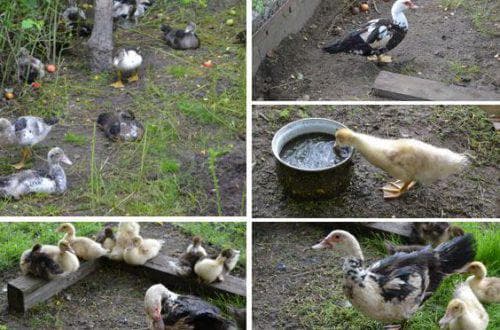
Then the monthly ducklings are transferred to the herd for growing. If you organize the feeding and maintenance correctly, Peking ducks can be considered beneficial for home breeding.You can keep a small amount for yourself, or organize a duck farm for the production of meat and eggs. Breeding Peking ducks is profitable, hatching eggs, purebred ducklings and adults are not cheap. Crossbreeds with other breeds and species can be profitable, for example, you can start breeding mulard.
Frequent illnesses
Ducks that live in a damp and blown room suffer from colds. Little ducklings can die from this. For adult ducks, diseases and problems are characteristic:
- clogged esophagus caused by rough greens;
- prolapse of the oviduct in females, the reason is large eggs, treatment is washing the oviduct with potassium permanganate or alum for 5-7 days;
- plucking feathers, the reason is a lack of vitamins and mineral elements, treatment is the addition of mineral and vitamin supplements, charcoal, crushed shells to food.
In order not to miss the onset of the disease, they observe the bird, more often examine it. At the first signs, such as decreased appetite, lethargy, depression or dullness and loss of feathers, contact your veterinarian.
For the prevention of infections, young animals are soldered with vitamin preparations, and vaccines are made. Clean and disinfect the premises, inventory, monitor the cleanliness of feed. Walk the bird in the fresh air, or better - on a pond where it will swim. Sick individuals should be removed from healthy individuals during treatment and returned only after recovery.
Peking duck is known to poultry farmers who keep ducks for meat or for breeding. The breed has many advantages and few disadvantages, for which it is appreciated. Peking people grow quickly, feed meat on a simple, standard feed, its quality is recognized by all culinary specialists.
